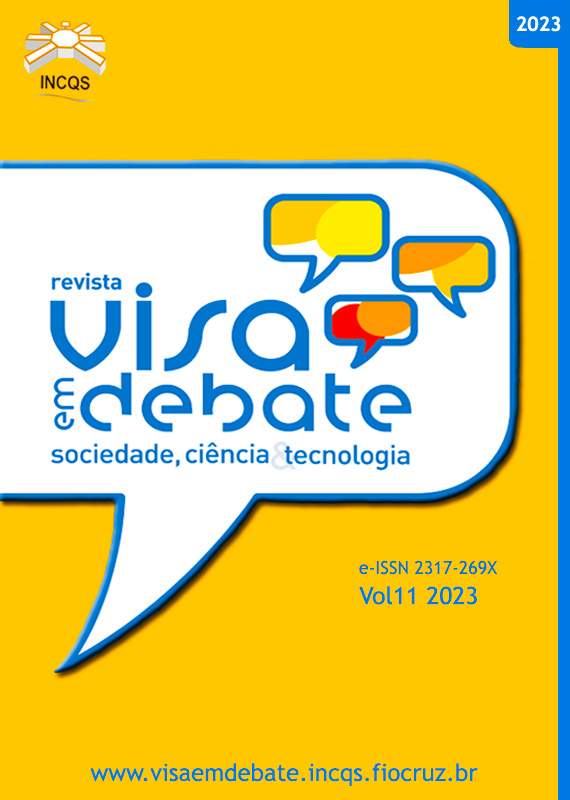Latin American scientific production on nanotechnology-based products to fight COVID-19: a scoping review
Vigil Sanit Debate, Rio de Janeiro, 2023, v.11: e02002 | Published on: 27/02/2023
DOI:
https://doi.org/10.22239/2317-269x.02002Keywords:
COVID-19, Coronavirus Infections, Nanomedicine, Nanotechnology, Scoping ReviewAbstract
Introduction: Scientific production has experienced an unprecedented increase with the COVID-19 pandemic in a short period of time. Objective: To identify and characterize the Latin American scientific production on anotechnology-based products with potential applications in the areas of diagnosis, vaccine, pharmacological treatment, theranostics and non-pharmacological intervention to fight COVID-19. Method: A scoping review was conducted based on the framework of Arksey and O’Malley and sought to incorporate recommendations from the Joanna Briggs Institute Reviewer’s Manual and Preferred Reporting Items for Systematic reviews and Meta-Analyses extension for Scoping Reviews (PRISMA-ScR). The bibliographic search took place in PubMed, Science Direct, LILACS and SciELO. Studies that reported nanotechnology-based products with potential applications in the areas of interest referenced previously were included. A simple quantitative analysis was conducted to provide numerical summaries of characteristics of interest from the studies added to the review. Results: 26 (3.4%) articles published in 14 international and regional journals were included. Authors from five countries (Brazil, Chile, Costa Rica, Ecuador, and Mexico) were responsible for the total number of articles that made up the review. The production of 6 (23.1%) articles included international collaboration, involving institutions from 10 countries. The median time from submission to publication of articles was 126 days (interquartile range: 58–200). Most of the Latin American scientific production consisted of narrative reviews (n = 19; 73.1%). The five areas defined as of interest for this study were addressed by one of the scientific articles, especially the products intended for pharmacological treatment of COVID-19 (n = 14; 53.8%). Conclusions: This is the first scoping review to provide a map of Latin American scientific production on nanotechnology-based products with potential applications in areas of interest to fight COVID-19. There are deficiencies related to the publication of basic research, representativeness of Latin American countries in the region, studies with greater strength of evidence and to international collaboration to produce scientific articles that merit to be reduced.
Downloads
Published
Issue
Section
License
Copyright (c) 2023 Daniel Marques Mota, Paulo José Gonçalves Ferreira, Fabian Teixeira Primo (Autor)

This work is licensed under a Creative Commons Attribution 4.0 International License.
COPYRIGHT ALLOWANCE The author (s) hereinafter designated as the ASSIGNOR hereby assign and transfer, free of charge, the ownership of the copyrights related to this ARTICLE to the Vigilância Sanitária em Debate: Sociedade, Ciência & Tecnologia (Health Surveillance under Debate: Society, Science & Technology) – Visa em Debate, represented by FUNDAÇÃO OSWALDO CRUZ, established at Av. Brasil, nº 4365, Manguinhos, Rio de Janeiro, RJ, Brazil, CEP 21045-900, under the conditions set out below: (a) The terms and conditions set forth in this Agreement shall apply to the following: 1. The ASSIGNOR declares that they s(he) is (are) the author (s) and owner (s) of the copyrighted property of the ARTICLE submitted. 2. The ASSIGNOR declares that the ARTICLE does not infringe the copyrights and / or other property rights of third parties, that the disclosure of images (if any) has been authorized and that they s(he) assume(s) full moral and / or property liability for its content, before third parties. 3. THE ASSIGNOR assigns and transfers all copyrights relating to the ARTICLE to the ASSIGNEE, especially the rights of editing, publication, translation into another language and reproduction by any process or technique. The ASSIGNEE becomes the exclusive owner of the rights related to the ARTICLE, and any reproduction, totally or partially, is prohibited in any other means of publicity, printed or electronic, without prior written authorization from the ASSIGNEE. 4. The assignment is free and, therefore, there will be no remuneration for the use of the ARTICLE by the ASSIGNEE.







